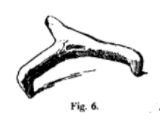


Stilts are small supports used when firing glazed ceramics to stop the melting glaze from fusing them to each other or the kiln. [1] [2] [3] Stilts are a form of kiln furniture. [4] Their presence in archaeological sites, where they may be known as pernette, along with other kiln furniture such as saggars and kiln bars can be used to support a case for local production. [4] Some potters avoid the need for stilts by not glazing the bottom of their products. [5] This is known as dry footing. [5]

